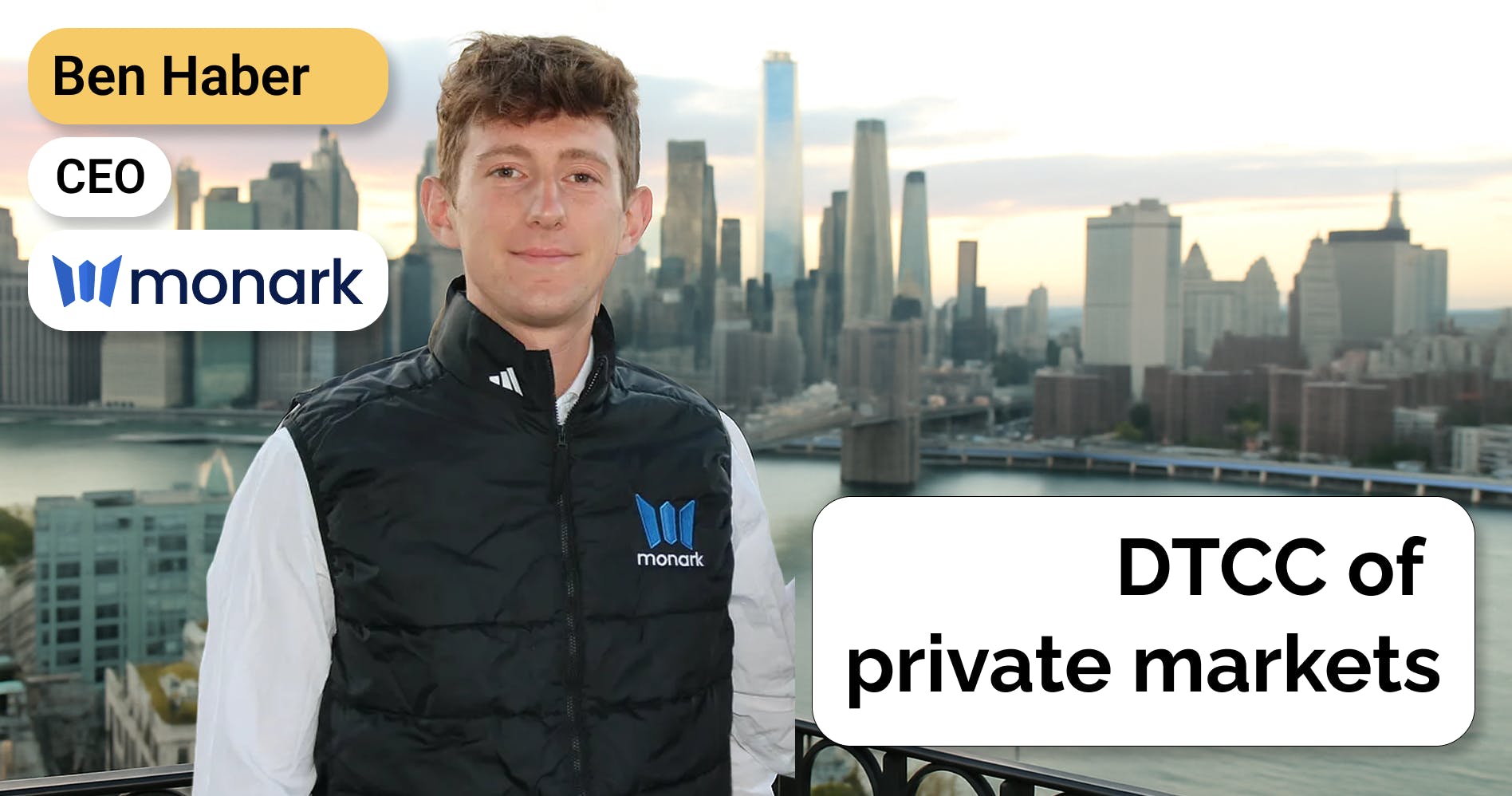Nik Talreja, CEO of Sydecar, on powering the future of secondary trading
 Walter Chen
Walter Chen

Background
Nik Talreja is the CEO and co-founder of Sydecar. We talked to Nik because Sydecar sits at the middle of two big intersecting trends: 1) the rise of emerging managers via ecosystems like AngelLists, and 2) the growth of private marketplaces for buying and selling secondary stock.
Questions
- What is Sydecar?
- What inspired you to build it?
- Can you talk about your early product market fit? What did that look like? Who are your customers? How do they use Sydecar? What are some of the key milestones you’ve hit?
- Can we talk about the services vs. tech aspect? You started as a services business that you then found places to automate. Is there kind of a core technology that you're leveraging?
- Can you help us understand, in the pre-Sydecar world, why SPVs would cost $8K? What will that number look like in the post-Sydecar world?
- Can you walk us through one customer segment—the $50K SPV—and how Sydecar is enabling people to raise this? What differentiates your SPVs for investors and founders and the API B2B type of product in the market? What does your revenue mix look like today?
- With regard to AngelList, they have an AUM too where it might be $5K plus 0.5% of the value of the SPV. Do you also have some sort of an equity model built in?
- Can you talk about the ecosystem of emerging managers that Sydecar supports off of AngelList? What do they look like? How do they build an audience and engage with LPs outside of AngelList?
- Those dynamics are obviously very much like Shopify, Amazon, YouTube vs. Wistia. Yes, it's interesting to think about that. What does the tech stack look like?
- How do you check and gather indications of interest? Is it on Google Forms still or Google Sheets?
- Across 2020-21, how are you seeing demand at Sydecar shift now that that frenzy in private market activity has dropped off a bit? Are you seeing demand from different types of investors or more interest in secondary?
- There have been a few entrants into this space—Assure, Allocations, Flow, Vauban. How are you positioning Sydecar vis-a-vis them?
- Carta has this network of companies and investors through the cap table which they've used to sell different products to investors, like fund admin. Can you talk about Sydecar and your positioning with respect to Carta in that type of a product?
- With regard to positioning against AngelList, it’s possible that Sydecar could be the SPV for provider to them using the API product. Can you talk about this dynamic that you might have with the marketplaces that you work with?
- Do you think of Passthrough for instance, as a potential partner or potential competitor, as Sydecar expands its footprint across all the things that it's going to do?
- What is the vision or thesis for Sydecar becoming a core infrastructure for every marketplace and essentially every private markets' transaction?
- Is facilitating secondary liquidity a huge part of the vision? How big of an upside opportunity do you think this is for the business?
- How do you think about international expansion? Is that sort of a five, ten year vision? How important of a piece is that to the future Sydecar vision?
- What does Sydecar become in five years’ time? How will the world then be different in terms of venture investing?
Interview
What is Sydecar?
Sydecar, in brief, is an on-ramp for emerging venture capitalists.
I think of the term “emerging venture capitalist” pretty loosely. To me, it means anyone that may be starting their first syndicate, their first fund, or building a business that is adjacent to capital deployment in the VC ecosystem and wants to participate in transactions. They could even be a large institution that just hasn't previously touched alternative assets or venture capital as an asset class for its clients.
For anyone emerging into VC investing, we're creating the infrastructure for them to start a business, deploy capital, and manage investments. We take care of all of the background, whether that's entity formation, banking, compliance, tax, and all the nuances that honestly, no one wants to think about.
What inspired you to build it?
I practiced law at major law firms like Cooley and Weil and ended up founding a firm called Talis Partners. As part of that process, I ended up building a book of business working with emerging companies in Silicon Valley and beyond. That was really enjoyable. I got to help steer our clients through both legal and strategic issues. I got really close to a lot of founders and then, into networks of other founders.
At a certain point, I reached a limit on how much I could serve my clients because the practice was small and we didn't really want to scale it. I was doing this more as a lifestyle business and something that I really enjoyed personally. I was like, "Hey, how do I get exposure to these other companies I think are fascinating?" The best way was by investing in them.
I started off by throwing in small checks myself—$5K, $10K, $15K, $25k. I had tons of conviction, but realized, "Hey! I can't do this continuously, because I'm going to go broke. I'm not going to see a return for a decade."
That led to me launching my own syndicate with my co-founder, David. We called it 18 Ventures.
It was really in forming our own syndicate that we realized the need for Sydecar. We had formed a small group of individuals who would give us capital to deploy into companies. It was clear though that if we took that group and to a marketplace like an AngelList, we might be far less special, far less unique in their eyes. It might become a lot more difficult for us to take this syndicate model and scale it into a fund. Our LPs would have access to tons more deal flow through a marketplace, which would make it a lot more difficult for us to stand out from the crowd and build an enduring business. We knew we needed to be intentional in building our LP network.
We realized that there was truly nothing that existed at that time that would allow us to highlight our brand and what’s special about us in the eyes of our LPs AND give them the ability to interact with us in a low friction way with a great user experience. Nothing that would allow us to put the focus on the deals we were bringing to the table and the relationships we were building – because there’s too much friction created by all of the legal paperwork, the compliance filing, etc.
We ended up just creating and administering our own SPVs because that was the only solution that really made sense at the time from a cost perspective. Our deals were roughly $100K-$200K in size. We couldn’t justify spending $12-15k for a deal that size.
Launching and managing our own SPVs really just opened my eyes to the possibilities that could exist if there was a real product company that specialized in helping people build a business and venture capital. It made me realize that so much of the friction when it comes to VC deal making is due to the lack of industry standards.
To make an analogy: if you're a company raising capital at the pre-seed or seed stage, you frequently leverage what's called the YC SAFE (Simple Agreement For Equity) that they've pioneered and said, “This is the one best way to raise money if you're an early stage company.” But if you're an emerging VC, there is no standard. It's a world before SAFEs for companies, where you had hundreds of different forms of convertible notes and you named all different types of KISSes and so on. If you're a VC, there's nothing standardized.
What dawned on us very quickly when we were creating our own SPVs was that we could create that standard. We could create the one gold-standard for aggregating and deploying funds into private companies, so anyone in our position could just trust a single company that's extremely credible, has a strong commitment to compliance, and provides them to tools to create a real enduring business in venture capital.
What if we could create something for that audience – not only create this document, but a product that really does everything from an automated standpoint to reduce the cost to a point where you can do that $50,000 deal? How awesome would that be?
That's how this business started. It was really for us.
Can you talk about your early product market fit? What did that look like? Who are your customers? How do they use Sydecar? What are some of the key milestones you’ve hit?
If we rewind the tape to when we started the business, it was us. We were the first customers.
But then, what quickly happened was there was this tremendous business pull. I still had my law firm and through that I'd meet venture investors as well as companies. Venture investors would come to me and say, "Hey! Can you help me spin up an SPV?" I’d be like, "Funny that you asked, I'm actually working on this product to do exactly that."
That catapulted us forward because one customer then introduced us to five more. We ended up getting 40 customers in our first four months thinking about this problem. That was honestly what catapulted us forward into our first raise where we raised on this thesis of “Shopify for deal makers”.
Honestly, I wouldn't say it was product market fit in the early days. It was truly service market fit but with strong intuition that that could be a product one day. That's what pulled us in.
January 2021 was when we formally started the business. Over the course of last year, we really turned the service into a product. We started automating all of the points of friction, whether it's entity formation, banking, so banking could be practically real-time forming accounts, tax and automating tax, so that you could basically take ledgers tied to SPVs and automate how they're utilized to draft tax returns and file returns with the IRS and other agencies, compliance filings etc.
Over the course of the last 14 months, we've done north of 300 transactions, administering something like $400 million in transaction value. We touched thousands of investors—the last number was just north of 4,000.
It's growing by the day, so it's been a fun trajectory. The last 14 months have been really when we've been in business and it's been a pretty quick uptake.
Can we talk about the services vs. tech aspect? You started as a services business that you then found places to automate. Is there kind of a core technology that you're leveraging?
It's not like there's a silver bullet technology piece that pulls everything together and says, “This is what makes side currents stoppable. It's more aligned.” The silver bullet then, would probably be the vision, which is around creating the standard—the one way to transact.
Sydecar has been able to automate where other players in our space have not because we only accept one way of doing business—our way. When you work with Sydecar, you’re accepting our standard way of doing things – whereas everyone else in the ecosystem says, “You have your own documentation that your council drafted. Cool, we'll help you with that. We’ll figure out how to take that on, because we have an army of accountants and lawyers behind us that will interpret what's there and help you with reports and tax season." But what they don’t consider is that, by accepting every single different way of doing things, every different set of custom legal documents or banking partners or reporting requirements, they create an immense amount of friction and inefficiency. They create reliance on manual processes and opportunities for human error.
At Sydecar, we say: “This is our one, standard way of doing things. We believe it’s the best way and the one that will create the least amount of friction for you (our customer).” Pushing forward our standardized way of doing business isn’t about being overly rigid or static. Our standard, and our infrastructure, will be constantly responding to what the market is asking for.
Our standard starts with an SPV, which is the most simple of venture vehicles. It's going to evolve over the course of the next few months to include a novel fund structure and more. But everything that we introduce to the market will be pioneered by us, based on what we think is the best standard for the ecosystem, largely informed by my experience as an attorney for over a decade.
Using that intellect and applying it to how we do business is our secret sauce. The technology that backs that is the infrastructure that powers Sydecar. Since we've taken that standard and said, “This is how we operate,” and built a verticalized software stack that allows us to automate the back office operations, we can offer what we do at a much lower price point in the market than our competition. We’re not trying to race to the bottom on price today, but we’re confident in our ability to operate more efficiently than others in the market.
The way we’ve built product has also allowed us to present a frictionless user experience. When you bring your LPs to Sydecar, you’re not having to introduce new agreements, new forms, DocuSign requests, whatever every single time. It's seamless and takes far less time than anyone else because it's truly verticalized.
Can you help us understand, in the pre-Sydecar world, why SPVs would cost $8K? What will that number look like in the post-Sydecar world?
The number $8K is stuck in your head because of AngelList, a trailblazer in our industry that I deeply admire. Every single time you do a deal on AngelList it’s via syndicate, which is their version of an SPV product, and it's $8K. They may be different today and I don't know exactly what it’s priced at, but they said, “Rather than pass through regulatory fees and scale it, we'll make it so predictable that you know exactly how much to raise every single time, when you want to deploy capital.” This is honestly genius, because it's simple.
But $8K doesn't work for every deal. If you're raising $50K, your LPs might not accept a 16% fee ratio. You're going to think twice about it, so it doesn't work for everybody.
There are so hard fees that go into creating and administering an SPV. If you’re creating an entity in Delaware, for example, you have to actually file something with Delaware and pay them to maintain it. You have to work with what's called a registered agent. You may have to pay banking fees, or pay for a DocuSign subscription. And the biggest cost on the admin side is (typically) Blue Sky fees. Blue Sky fees are basically a fee you have to pay in every state where you have an investor in an SPV. To serve them a notice basically saying, "Hey! Someone in your state invested in an SPV," and they can charge anything from maybe $100 to $1,200 or, maybe $1,500 on the true high end depending on the size of the deal and the amount of capital being deployed in that state.
Then there’s tax and tax filings with the IRS. Historically, this means paying accountants, tax advisors, and filing returns. But what we've done in Sydecar is basically create a product to essentially remove all of those fee barriers except for the Blue Sky fees, which is something you can't disregard unless you're just not being compliant.
Now AngelList was like, “Let's do away with all that friction.” All those fees put them at $8K on average. We're making some money, maybe losing some money in other deals. Other businesses in our space have said, “Let's pass through those Blue Sky fees and some other additional expenses so that our fee looks clean on paper.” But really, you don't know how much you're going to pay in fees.
We want our customers to have some concept of these underlying fees, and what actually goes into creating and administering an SPV, without actually having to worry about all the nuances and fine print.
Our goal from the beginning was to make pricing as transparent and predictable as possible. We don’t want to pass through unknown variables like Blue Sky fees. We’ve also made our fees scalable, so that you can run a $50k deal or a $50 million deal without thinking twice.
Can you walk us through one customer segment—the $50K SPV—and how Sydecar is enabling people to raise this? What differentiates your SPVs for investors and founders and the API B2B type of product in the market? What does your revenue mix look like today?
We started a business with a really simple transaction based revenue model. You pay us when your deal closes, you don't pay anything upfront just to launch a deal. Launching a deal involves creating the whole legal architecture, bank accounts, and everything else to receive capital to fund an opportunity. We basically pull our transaction fee out when you actually deploy that capital into a company.
This is the best pricing model for our customers today, because it lets them get into business without worrying about upfront fees, or cancellation fees if a deal falls through for reasons out of their control.
But, as we look forward to a future state for Sydecar, I actually think the lion’s share of revenues won’t be transaction based. As we roll out additional products, including a fund structure, a white-label product, and an enterprise solution, we become more of the infrastructure. We become a home for people to come to launch and run their business, to tell their story and build their brand. This creates an opportunity for a recurring revenue business.
One thing I haven't mentioned yet is that because we've taken this staunch view of standardization at the SPV level, that gives us the chance to think about transactions within the SPV at a future state. Let's say someone wants to exchange an interest in an SPV for cash, to get liquidity. We can support that programmatically, because we’ve built our own, proprietary ledger that tracks capital flows and ownership in a really elegant way. We envision a world where secondary exchanges occur within SPVs (rather than on a company’s cap table), which removes a lot of the friction. It's this elegant place to transact and we can charge for that, because it happens on our ledger.
With regard to AngelList, they have an AUM too where it might be $5K plus 0.5% of the value of the SPV. Do you also have some sort of an equity model built in?
Not today. Never say never, but I'd be surprised if we ever turn on a model where we participate in the upside and act like a marketplace. The reason for that is our value prop is all about being there for our sponsor customers and not contacting or utilizing those LP relationships for any reason other than to promote what they want to promote.
Can you talk about the ecosystem of emerging managers that Sydecar supports off of AngelList? What do they look like? How do they build an audience and engage with LPs outside of AngelList?
I think it may help to think about who would use AngelList, first, and then, we can think about the world outside of AngelList. By no means am I trying to pontificate around what people should do. But speaking from my own personal experience, although I had a close tie to AngelList when I started syndicating my first few deals, I did not want to use AngelList because I wasn't relying on them for capital.
The major value prop of using AngelList is, if you don't have access to LP capital, they can help connect you with LPs and capital.
Now if you’re an aspiring venture capitalist, especially if your goal is to raise a fund at some point, I would argue that bringing your relationships to a marketplace, and building your business there, isn’t in your best interest.
The marketplace model also means that AngelList is associated with retail investors. There’s a stigma there. Some companies don't even want their deals on AngelList because they feel being associated with them may be a negative signal to other investors in their cap table. I don't think it's necessarily right, because I feel AngelList has a strong value prop, it's a huge value to the community, but the stigma exists.
For those reasons, more emerging VCs –especially new segments entering the ecosystem like athletes and influencers – would prefer not to use AngelList today.
Those dynamics are obviously very much like Shopify, Amazon, YouTube vs. Wistia. Yes, it's interesting to think about that. What does the tech stack look like?
Exactly. Like Shopify, we want to provide all the tools our customers need to build their business. We’re still figuring out what all of those things are and building towards that vision. Our customers still have to use other tools.
Today, our customers use Sydecar for transactions – that means inviting people to a deal page and allowing them to sign docs and fund an investment. Our customers also rely on us for all the management post-closings, like tax and reporting.
Now how do you get people to even commit? Where do you tell your story, today? That tends to happen in various places. It could be email, Slack, Discord, Text, or WhatsApp. How do you track who you've talked to? How do you track opportunities? That could be Notion, Airtable, Google docs—it's honestly a hodgepodge.
Actually someone on our team, Halle Kaplan-Allen, published this piece about the emerging fund managers toolbox. If you look at what she published, it still rings true today—it's 10 different tools. Our vision is not to replace all 10 tools, because we know we can’t do the best job if we don’t stay focused. Maybe we replace three or four of them. There's definitely an opportunity to consolidate some of this hodgepodge activity.
How do you check and gather indications of interest? Is it on Google Forms still or Google Sheets?
It's all over the place including via text messages. We're building a product for that because it’s super connected to where we start our operation today. Supporting the gauging interest phase and making it really low touch is something that would logically live on the same platform where a deal is executed.
Across 2020-21, how are you seeing demand at Sydecar shift now that that frenzy in private market activity has dropped off a bit? Are you seeing demand from different types of investors or more interest in secondary?
There’s no question that there’s been a change in the overall VC ecosystem. But there is still a ton of wood to chop right in front of us. Deals are still getting done.
If there were, let’s say, 10,000 deals done last year, it feels like there are 6,500 - 7,000 deals this year. Of that number, what do we need to capture to have a really great business? Not a very large percentage, if you think about it.
So we're not seeing a slowdown. What we’re noticing is that, as investors calibrate to the new environment, they actually care more about things like user experience, cost, transparency, trust, and credibility – all of our value props. They embrace standards more than maybe they would've thought about before because in the past, maybe it was all about whatever is right in front of you just get it done. Now, it's “Let's be thoughtful about who we're partnering with.” I mean, just anecdotally, we've been seeing growth as a business. That's all through organic efforts. We spent almost zero in actual marketing efforts, so it hasn't really hampered our ability to grow in this ecosystem.
There have been a few entrants into this space—Assure, Allocations, Flow, Vauban. How are you positioning Sydecar vis-a-vis them?
It comes down primarily to standards in our approach. You come to Sydecar because you are willing to accept that Sydecar's way of transacting, because you value the efficiency it creates. It's like using Stripe versus the hundreds of different card processors that preexisted Stripe for ecommerce. When you leverage Stripe, you know exactly what to expect, the user experience is great, and things happen the way you want it to happen.
We're positioning ourselves almost as this Stripe contender versus “Hey! Build your own, bring your own. We'll just modify your website to enable ecommerce or payments for your website.” Honestly, that rings true for how we think about the business as we go from here including our fund product, our enterprise partnerships, our API, and white label.
We don't rely on hundreds of people to run our business. We rely on a product to do so. Come tax season, you don't need to worry about your investors receiving K-1s on time, because those forms are just generated by the product. That's what everyone really cares about and that's why we win business against our competitors. Whether it's a first time fund manager running a $25,000 deal or a large fund running a $100 million SPV, they want the exact same thing. They really believe in us as people, in the product we built, and the standards that we are championing.
Carta has this network of companies and investors through the cap table which they've used to sell different products to investors, like fund admin. Can you talk about Sydecar and your positioning with respect to Carta in that type of a product?
For me, this comes down to the benefits of focus, picking an audience that you really want to serve well, and building for them. If you're a Carta, or even AngelList today, you're catering to a bunch of different stakeholders who don’t have the same priorities. The companies, the fund managers, the investors, and everything in between—maybe even employees at companies for equity incentives and beyond. There's no way, in my opinion, to serve all of these different audiences extremely well.
Sydecar's taken a position of “We're serving one audience really well” and those are deal organizers who are happy to accept a new standard. Now that may not be 90% of the market today. Perhaps today is 20 or 30% and growing – but our vision is to expand this market and tap into an audience that really wants what we've built, without taking on the debt of just saying yes to everyone.
If you’ve accepted a bunch of different types of structures like Carta has, and you’re catering to all these different stakeholders, you can't then turn all that off tomorrow. You're not going to write off 80% of your revenue.
We're building 80% of our revenue from this new audience that no one really has to pay as much attention to as we do. We're never going to lose focus on that because we believe this is the future of venture capital.
With regard to positioning against AngelList, it’s possible that Sydecar could be the SPV for provider to them using the API product. Can you talk about this dynamic that you might have with the marketplaces that you work with?
My vision for the future of Sydecar is one where we're powering other marketplaces. We're not the marketplace. You can think of Sydecar as almost a NASDAQ for private markets that is basically powering the vehicles to sit on company cap tables.
In a future state where companies remain private far longer than they do even today, you need a place to create liquidity. In the public markets where you exchange through various brokers, you don't ever exchange interest in the company cap table directly in the public company. However, in future, you may be exchanging hands of interest in a company through a Sydecar vehicle that you don't even know you've actually entered or left. But we're powering a marketplace that you've been a part of.
That would be a vision that if we can actually realize I would feel I've made a mark on a part of the world that I really care about. That's my dream and what I'm building to. It would be a dream come true for me to work with AngelList in that way. I really respect their team among many other teams that we compete with today.
Do you think of Passthrough for instance, as a potential partner or potential competitor, as Sydecar expands its footprint across all the things that it's going to do?
Piggybacking on what I just said, I view literally everyone in our ecosystem as potential partners. This is not a winner takes all market. What we're really good at, we are the best at. The transaction piece through fund structures or through an SPV in our fund vehicles in the future, we will be the best at.
If a company like Passthrough wants to engage in that activity and monetize it, it would make the most sense to partner with us. I've met the Passthrough team a number of times, and I think they're amazing. I respect what they're building, I understand where they're going with the business. I can definitely envision us partnering in the future.
What is the vision or thesis for Sydecar becoming a core infrastructure for every marketplace and essentially every private markets' transaction?
The thesis really starts on this notion of standardization in a market that has no standards today. Certainly, in venture alone there is a lot of disarray, disorganization, and no clarity on how you enter the market as an investor today. To me, that does not need to exist. By just distilling the noise and saying, there is a standardized approach to investing at a venture investor, we're putting our flag in the ground and saying, "This is infrastructure that everyone should use in some way and some touch in some way."
We're building it first for ourselves and our audience with a front facing application. This year, we're branching out from there and saying, “We don't need you to use our front facing application to interact with our infrastructure. You can still leverage our ability to create entities, to leverage banking, to handle reporting, to leverage ledgers for really efficient transactions on an SPVs cap table or a fund instructor's cap table Using just our infrastructure via an API,” for example.
So our thesis for growing in that direction is to start to branch from front facing to integrated and embeddable. Then, the future becomes a lot more clear around how that could work in a sense whether you're a marketplace, an institutional bank, a company like Passthrough, or maybe even an AngelList or a Carta. Rather than build a whole business or a market around a back office and have to worry that it's a cost center, get the efficiencies and benefits of what we've built in the future when it comes to multiple transactions within these vehicles.
Let's say, you have 10 different marketplaces with 10 different standards. That still doesn't work in a market. A small number of players heightens a need for transparency and standardization. It makes the most sense for us to really stay true to that value prop and push that as long and as hard as possible to as many players as possible to get everyone the benefit of things like liquidity in the future.
We're going to stay true to that. We're starting with the API this year, maybe a white label going into next year. From there, I don't know exactly how we’ll continue to champion it but I know that every single player that adopts our standard helps our momentum.
Is facilitating secondary liquidity a huge part of the vision? How big of an upside opportunity do you think this is for the business?
I think it's the holy grail. I think the market needs is a true sense of what liquidity could look like. Whether or not Sydecar is enabling it from a marketplace standpoint is besides the point. But there’s no question that there needs to be a place where there's adequate information to transact in an efficient way in private markets. Without true liquidity, there's a natural cap to people who are willing to take the risk.
Liquidity will help bring more players into the market - from retail to high net worth to family office to institutional investors. More players in the market is good for innovation.
The future, I think, is a lot more real-time, getting in, getting out, getting in, getting out and the only way to make that happen is with what we're building at Sydecar. That's what I'm really passionate about seeing it come to fruition.
How do you think about international expansion? Is that sort of a five, ten year vision? How important of a piece is that to the future Sydecar vision?
It's very important, but it's very important that it happens within our standards so that we can continue to build towards the vision I just laid out. Anything that could throw us off that vision is a long term risk, even if it adds incremental revenue today.
Today, we can support investors from practically anywhere in the world. Of course, there are some friction points for some international investors especially when it comes to banking that we can’t realistically do much about. But all of our SPVs - whether they are organized by an international deal lead, accepting funds from international investors, or investing into an international company - are structured as Delaware entities.
Let's say we want to expand internationally and support entities in other jurisdictions. Are we going to enter a jurisdiction that will not allow us to support a secondary transfer at some point? Or is it far more full of friction because of things no one can control like regulatory issues or filing times, etc.?
Maybe we can charge an extra 10k for that type of deal – and perhaps that's what our competitors would do. But for us, we're only going to support jurisdictions that allow us to actually transact in the ways we wish to transact five years from now.
That actually reduces the number of places we can go, but we are still going to go there. It's just a matter of time before we actually figure out where we want to put another flag in the sand in another jurisdiction.
What does Sydecar become in five years’ time? How will the world then be different in terms of venture investing?
If everything goes well at Sydecar, in five years there will be thousands of investors who have transacted on Sydecar’s rails without even realizing it. But since the investment is managed on Sydecar, you have a chance of actually creating liquidity for yourself. That's because we've made for a more frictionless actual liquid market within the private ecosystem that cannot exist without standardization.
The one thing I would add is nothing we do at Sydecar can be done by any one person. Our greatest asset is truly our team. We were at an offsite last week and the energy from our team was incredible. We all love this crazy vision that only so many people in the world can even understand. That makes me so happy. That's what gives us the power to get to this vision in five years—it's the team. We have a remarkable team
Disclaimers
This transcript is for information purposes only and does not constitute advice of any type or trade recommendation and should not form the basis of any investment decision. Sacra accepts no liability for the transcript or for any errors, omissions or inaccuracies in respect of it. The views of the experts expressed in the transcript are those of the experts and they are not endorsed by, nor do they represent the opinion of Sacra. Sacra reserves all copyright, intellectual property rights in the transcript. Any modification, copying, displaying, distributing, transmitting, publishing, licensing, creating derivative works from, or selling any transcript is strictly prohibited.











